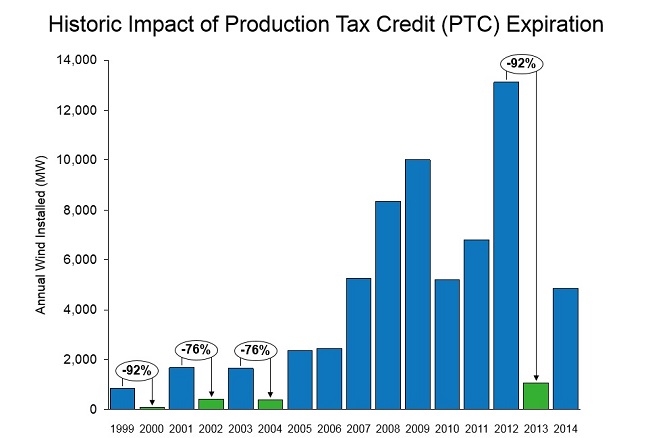The Obama Administration has placed a high priority on reducing U.S. reliance on foreign oil and increasing the country’s energy independence, particularly through more use of clean, renewable energy sources. In the January 2015 State of the Union address, President Obama called attention to the fact that America is the global leader in the amount of electricity generated from wind power. But while the Administration continues to push for development of more wind power infrastructure, we’re seeing increasing pushback in state legislatures and in the courts. We focus on how the legislative environment has affected the economics of wind power in this post, and we’ll examine the effects on the communities in which wind projects are built and some of the resulting litigation in later posts.
In March, the U.S. Department of Energy released Wind Vision: A New Era for Wind Power in the United States, a report highlighting the benefits of investing further in wind energy. In its fact sheet promoting the report, the White House stated that between 2009 and 2013, approximately 30% of the new electricity generation in the United States was from wind power. The growing industry has been credited with boosting the economy by supporting 50,000 American jobs and generating more than $400 million in exports in 2013 alone. And new technology, such as taller, more advanced wind turbines, is enabling states to take advantage of wind for power production where they were unable to in the past with conventional technologies. With continuing technological advancements, cost reductions, and infrastructure development, the Administration anticipates that wind power could be available in all 50 states by 2050, sustainably providing up to 35% of our nation’s electricity.
Unfortunately, much of the growth in the wind industry has been dependent on government regulations such as state renewable portfolio standards (RPS) and financial incentives from tax credits. According to the University of Michigan News, RPS are active in 28 states, and 74% of Americans surveyed agreed that state governments should require a specific portion of all electricity to come from renewable sources such as wind, solar, or biomass. Despite that strong popular support, these renewable energy requirements are increasingly being challenged. In June 2014, Ohio froze its RPS for 2 years to further study the issue, and many analysts expect that the state will reduce the original 2025 goals. In February 2015, West Virginia became the first state to repeal its RPS, and similar attempts are underway in several more states. Texas, one of wind power’s greatest success stories so far, is also trying to repeal their RPS, as is North Carolina.
So, while 69% of the wind power capacity built in the United States from 1999 through 2013 was developed in states with active RPS, many states claim that these renewable energy requirements have done their job and are no longer needed. The number of active programs shifts frequently as states pass new RPS, allow them to expire, or repeal them. Unless many more states follow Hawaii’s example in dramatically increasing their renewable energy requirements, RPS are not expected to require enough additional renewable energy development to sustain the average growth rate in wind capacity we have seen in recent years.
Unfortunately, just as the demand for wind power created by RPS is slowing down, the availability of tax credits is becoming increasingly uncertain. The federal production tax credit (PTC), which provided a 2.3‑cent per kilowatt-hour (kWh) incentive for the first 10 years of a renewable energy facility’s operation, has been an important stimulus. Originally enacted as part of the Energy Policy Act of 1992, the PTC has been allowed to expire and then extended six times, creating a boom-bust cycle of renewable energy development as shown in the chart below. Most recently, the PTC expired at the end of 2013. While Congress passed a bill on December 17, 2014 that retroactively extended the PTC for projects that were under construction by the end of 2014, it’s not clear whether the PTC will be reinstated again this year. The Senate voted in January on a measure that would have extended the PTC through the end of the decade, but it was soundly defeated.

Chart from American Wind Energy Association (AWEA).
Compared to traditional fuel sources, one of the benefits of wind power for consumers aside from the reduced emissions has been relatively stable prices. That’s because most state regulations allow developers of renewable energy projects to obtain power purchase agreements (PPAs)—long-term contracts, often 20 years, to sell power at specific prices. The PPAs were good for the companies developing the wind projects too, because it gave them a steady source of income on which to base project financing. Moreover, with the tax credits that have been available to developers, most PPAs have been set for relatively low prices. However, with the increasing uncertainty about whether the PTC will be renewed and other incentives will be maintained, many in the industry are starting to question whether long-term PPAs still make sense.
According to an April 2015 report from the U.S. Government Accountability Office (GAO), reducing state and federal renewable energy supports would likely reduce development of these projects. GAO’s modeling suggests that reducing or eliminating federal financial incentives such as the PTC would reduce the number of renewable projects built because developers’ returns would decline unless PPA prices increase enough to compensate for the reduction in federal support. For wind projects without the benefit of the PTC, PPA prices would have to increase 32% to 62% for developers to maintain their returns. How much development would actually decrease would depend on how states respond to reduced federal support and the associated increase in prices. Many states limit how much retail electricity prices can increase, thereby limiting PPA price increases, which could reduce development.
What do you think the government should do? Are you in favor of renewing the PTC and increasing renewable energy requirements with state RPS, or do you think the government has done enough and should let the market develop without further intervention? Let us know in the comments, and watch for the subsequent posts on local effects of wind projects and the resulting litigation.





Recent Comments